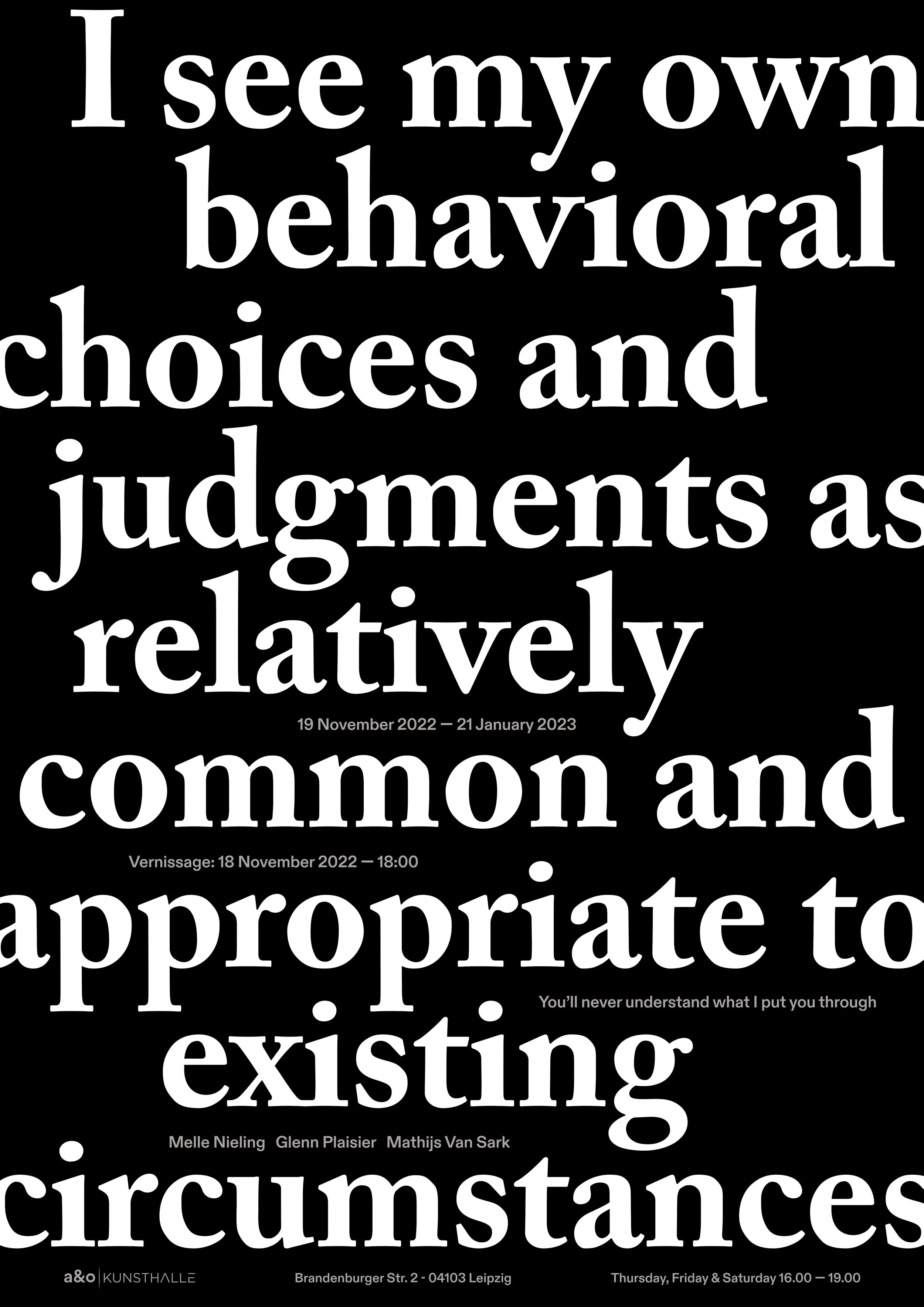The group exhibition "You'll never understand what I put you through" can at best be described as an unspectacular collection of attempts to question the human-object relationship. Oscillating between self-protective irony and a cynical post-truth, the presented works resemble the human scale in one way or another. The relationship between humans, objects and the intangible — such as constraints and confinements — is challenged through different understated redefinitions. The show is not structured around the presentation of singular pieces, but takes a structuralist approach in which the spatial construct of the white cube and the aforementioned intertwinements become a point of departure for both the viewer and the participating artists.
Although there are three positions presented in this exhibition, the notion of a singular maker is absent, as the works complement each other, in terms of both content and appearance. The artists collaborate and build further upon ideas they developed and accumulated over time. Working with the debris of the deconstructive tendencies of the 1960s and 1970s, they reassemble and borrow from traditional fields within the arts, while responding to it through the lens of this day and age. In doing so, the peculiar act of presenting is elevated to a space where one — still, finally, or again — can be incomplete and subjective, yet condemning its fundamentals in the exact same moment.It is precisely this paradoxical multitude that the show wishes to emphasise, yet never fully grasps upon; They’ll never understand what you put us through.
The three participants all come from the Netherlands and share the same alma mater: the AKI. At the time, the academy divided its departments according to the traditional pillars of the visual arts — painting, sculpture and new media — and focused on a hands-on approach to art education; figuring out the how, rather than the why. Over the last years, each of the participants has moved abroad to pursue their masters. In doing so, they departed from the artisanal nature of the institute to a more critical practice, away from the frame, towards the framework. For the first time since, this current exhibition brought them together and united through the conceptual root of their practices and the critical positions they have attained.
DATES
Vernissage: 18. November 2022 at 6 p.m.
Exhibition: 19. November 2022 - 17. December 2022 from 4-7 p.m.
Closed from 19. December 2022 - 4. January 2023
Exhibition: 5. January 2023 - 20. January 2023 from 4-7 p.m.
Finissage: 21. January 2023 from 4-7 p.m.
GETTING IN
Entrance is free and open to public. Opening hours are: Thursday - Saturday from 4-7 p.m. Special exhibition visits can be made by appointment via info@aokunsthalle.com.
GETTING THERE
For public transport options, check the venue link above. The a&o Kunsthalle Leipzig is located in the backyard of the a&o hostel Leipzig.
ABOUT THE ARTISTS
Melle Nieling (1992) graduated from the Critical Practice MA programme at the Royal College of Art in 2021. In the summer of 2022, he was invited for a residency at Künstlerhaus Dortmund with Plicnik Collective and received the Mondriaanfonds stipend for emerging artists. Nieling currently lives and works in London.
Glenn Plaisier (1987) graduated from the Design Research MSc. at the Bauhaus in Dessau in 2018 and has been living and working in Leipzig for the last seven years. In the beginning of 2021, the studio got reformed to a more substantive theoretical practice, thematising the conflicting conditions of the art world and macro-economics, rather than the actual production of art.
Mathijs van Sark (1992) ran the independent exhibition space “Nachtexpo” in the Netherlands for two years, before moving to Sweden. There he received his MFA in Sculpture from the Umeå Academy of Fine Arts in 2020. For two years he resides in Gothenburg, where he works and runs an artist space and workshop.

